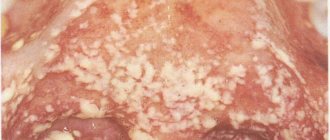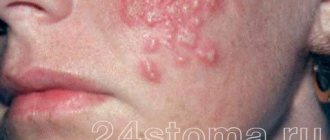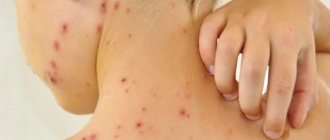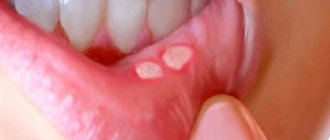Herpetic, or herpetic, stomatitis in children is very common. This is an infectious disease that affects the oral mucosa. It is caused by the herpes simplex virus, transmitted by airborne droplets or through contact with its carrier. Primary infection is almost always associated with a decrease in the functions of the immune system.
The manifestation of individual symptoms of herpes stomatitis in children depends on the form and stage of the disease. The forms of the disease include mild, moderate and severe, which is quite rare in childhood.
At the initial (incubation) stage, there are no obvious symptoms of the disease.
During the prodromal period of herpes stomatitis in children, the following appear:
- loss of appetite;
- sleep disorders;
- nausea and vomiting;
- enlarged lymph nodes.
When the disease reaches its peak, the following signs become noticeable:
- the appearance of blisters and ulcers on the oral mucosa;
- swelling and bleeding of the gums;
- heat;
- cough and runny nose (not always);
- general malaise.
During the period of decline of herpes stomatitis in children, the temperature drops, the general condition improves, but rashes in the mouth persist for some time.
Causes
Herpetic stomatitis, or as it is also called aphthous stomatitis, is dangerous, first of all, for young children. It is a serious viral disease, which, in addition to damaging the oral mucosa, causes general intoxication of the body and provokes malfunctions of the nervous, immune, and reticuloendothelial systems.
Herpes, which is the causative agent of the disease, may not make itself felt for a long time, although infection usually occurs in early childhood.
When the baby’s immunity is weakened, the herpes virus is activated and begins to multiply, causing an increase in temperature, enlargement of the submandibular lymph nodes, acute inflammation of the mucous membrane, and the formation of bleeding and painful ulcers on its surface.
Main reasons:
- decreased baby's immunity;
- previous infectious diseases;
- lack of vitamins;
- insufficient oral hygiene;
- direct contact with patients with herpes stomatitis.
Infants are more likely to become infected with the herpes virus during childbirth, provided the mother has a herpes infection. In children under one year old and school-age children, the virus is activated against the background of an organism weakened by disease and vitamin deficiency.
Etiology
Herpes viruses contain double-stranded DNA and have a glyco-lipoprotein envelope. The sizes of viral particles are from 120 to 220 nm.
Today, 8 types of herpes viruses that have been identified in humans have been described:
- two types of herpes simplex virus (HSV-1, HSV-2),
- varicella zoster virus (VZV or HHV-3),
- Epstein-Barr virus (EBV or HHV-4),
- cytomegalovirus (CMV or HHV-5), HHV-6, HHV-7, HHV-8.
Based on the biological properties of viruses, 3 subfamilies of herpes viruses have been formed: (alpha herpes viruses, beta herpes viruses and gamma herpes viruses). A-herpesviruses include HSV-1, HSV-2, VZV.
Betaherpesviruses include CMV, HHV-6, HHV-7. They, as a rule, multiply slowly in cells, cause an increase in the affected cells (cytomegaly), are capable of persistence, mainly in the salivary glands and kidneys, and can cause congenital infections. Gammaherpesviruses include EBV and HHV-8.
Main symptoms and signs of the disease
Acute herpetic stomatitis in children develops gradually and is preceded by an incubation period lasting from two days to 3 weeks.
Early symptoms of the disease are:
- burning in the mouth;
- increased salivation;
- headache, nausea, general weakness;
- increased body temperature;
- enlargement of the submandibular lymph nodes;
- the appearance of bad breath.
«
If the parents do not respond to the first signs, after a few days the mucous membrane becomes covered with multiple rashes. Small painful blisters itch, respond with acute pain to the touch, and when they rupture, a cloudy liquid flows out of them. The rash appears on the baby’s gums, cheeks, tongue, lips, and wings of the nose.
Herpes stomatitis can affect not only a school-age child, but also an infant.
The mild form of the disease can be easily treated at home; in moderate and severe forms, hospitalization of the small patient is indicated.
Varicella zoster infection
Varicella-zoster virus causes chickenpox and herpes zoster. The source of infection for chickenpox can only be a person with chickenpox or herpes zoster, including the last 24-48 hours of the incubation period. Convalescent chickenpox remains infectious for 3-5 days after the skin rash stops. The disease cannot be transmitted through a third party. Intrauterine infection with chickenpox is possible in the case of a pregnant woman. Chickenpox can occur at any age, but in modern conditions the maximum number of patients occurs in children aged 2 to 7 years. Herpes zoster develops after primary infection with the Varicella-zoster virus, after the infection passes into a latent form, in which the virus is localized in the spinal, trigeminal, sacral and other nerve ganglia. Endogenous reactivation of the infection is possible.
Classification and diagnosis
Herpetic stomatitis is classified both according to the severity of the disease and the characteristics of its course.
According to the characteristics of the course, acute and chronic (recurrent) forms are distinguished. Acute stomatitis is characterized by a sudden onset, pronounced symptoms, and rapid development. Without proper treatment, it quickly becomes chronic and can drag on for years, periodically exacerbating.
Based on the degree of severity, there are mild, moderate, and severe forms.
In mild forms, the following are noted:
- slight increase in body temperature;
- redness, swelling, inflammation of the gums;
- swollen lymph nodes;
- a small number of painful ulcers.
The average degree is characterized by:
- significant increase in body temperature;
- general weakness, nausea, headache;
- inflammation of the oral mucosa;
- the appearance of a blistering rash on the inner surface of the cheeks, gums, tongue, and around the mouth.
The severe form causes:
- temperature rise to a critical level;
- lymphadenitis of the cervical, submandibular lymph nodes;
- a sharp disturbance in general well-being;
- the appearance of severe muscle pain, headache;
- nausea, vomiting;
- multiple rashes that spread to the eyelids, conjunctiva, and perioral area.
Diagnosing the disease is not difficult for an experienced doctor. It is based on an analysis of the main symptoms, the order of clinical manifestations of the disease, the nature, and multiplicity of ulcers.
It is necessary to differentiate herpetic stomatitis from viral stomatitis; for this, in the first few days of the disease, a cytological examination of scrapings from erosions and aphthae should be done.
How long does the disease last and how many days is the child contagious?
Depending on the complexity of the form, herpes stomatitis in children lasts from several days to 2-3 weeks. With a mild form, the main symptoms disappear on the third or fourth day, treatment of a moderate form takes one to two weeks. The severe form is the most dangerous; healing lasts for weeks and requires mandatory hospitalization of the baby.
The disease is characterized by a high degree of contagiousness precisely during the period of exacerbation.
The infection is transmitted by airborne droplets (including through kissing), when using shared dishes, cutlery, toys, and hygiene items.
Herpes is contagious and can easily be transferred to healthy parts of your own body.
It is necessary to wash your hands thoroughly after treating the surface affected by the sores with medications to prevent the spread of the virus.
How and with what to treat herpetic stomatitis in children
As Dr. Komarovsky notes, treatment of herpetic stomatitis in children, regardless of age, depends on the severity of the disease, the general condition of the patient’s immune system, and the presence or absence of concomitant diseases.
The main question that interests young parents is which doctor should they contact if they suspect herpetic stomatitis. Both a qualified pediatrician and a dentist can advise the child.
Therapeutic methods include both general and local treatment. Common activities include:
- prescription of antiviral drugs (acyclovir, Zovirax, Herpevir, Virolex);
- taking antipyretic and painkillers (paracetamol, Panadol, Eferalgan, Tylenol);
- prescription of antihistamines (diazolin, claritin, erius, fenistil);
- correction of the immune system (immudon, sodium nucleinate);
- vitamin therapy (vitamin C, ascorutin, multivitamins, B vitamins).
Children of older preschool and school age are recommended to be treated with broad-spectrum antibiotics to avoid possible complications.
For newborns and infants, antibiotic therapy is prescribed only as a last resort, with preference given to local therapy:
- applications of painkillers (solution of lidocaine, trimecaine, pyromecaine);
- treating the baby’s oral cavity with antiseptics (solutions of furatsilin, potassium permanganate, brilliant green, blue);
- Treatment of aphthae with iodine should be avoided, as it causes a burn to the mucous membrane;
- the use of antiviral medications in the form of ointments, lotions, solutions (interferon, acyclovir);
- applying an oil solution of vitamin A, sea buckthorn or rosehip oil, solcoseryl to the mucous membrane of the baby’s mouth).
If the symptoms of the disease do not disappear on the 3-4th day of treatment, but only intensify, the child is indicated for treatment in a hospital setting, otherwise stomatitis will become chronic, from which it is impossible to get rid of it.
Virus activity
Most often, children are faced with the herpes simplex virus, which manifests itself in the form of that same cold on the lips.
Herpes on the lips or chickenpox are not as dangerous for a child as herpetic lesions of the eyes, genitals, and internal organs.
Externally, herpes appears as a rash on the skin or mucous membranes. It usually looks like small blisters that eventually burst and become sores. In addition to the rash, there is burning and itching.
How often the herpes virus is activated is influenced by hereditary predisposition and the state of the immune system. The weaker the child’s immunity, the more susceptible he is to virus attacks.
Newborns up to 1 year of age are protected by maternal antibodies. The peak incidence is observed at the age of 2-3 years. By the age of 15, up to 90% of adolescents are infected with HSV. The pathogen is in an inactive state in the body and does not cause discomfort. Under unfavorable conditions, HSV is activated. Source: A. Taieb, N. Diris, F. Boralevu, C. Labreze Herpes simplex in children. Clinical manifestations, diagnostic value of clinical signs, clinical course // Ann Dermatol Venerol, 2002, v.129, No. 4, p.603—608
Causes of exacerbations and relapses of herpes in children:
- decreased immunity due to severe and prolonged illnesses;
- severe shocks and chronic stress;
- systematic fatigue;
- hypothermia;
- taking hormonal medications;
- endocrine pathologies;
- hormonal changes in adolescence;
- systematic unbalanced diet;
- complicated seasonal colds;
- chemical and radiation anticancer therapy;
- excessive physical activity. Source: M.N. Kankasova, O.G. Mokhova, O.S. Pozdeeva Frequently ill children: the view of an infectious disease specialist // Practical Medicine, 2014, No. 9(85), pp. 67-71
Treatment with folk remedies at home
When treating herpes stomatitis in children, it is extremely important to prevent the development of complications and transition to a chronic form. Therefore, all folk remedies are auxiliary in nature and should not replace full treatment.
To strengthen the child's immunity, a decoction of echinacea leaves, ginseng root, and rose hips is well suited.
Rinsing will help relieve itching, burning and pain. For these purposes, you can use decoctions of chamomile flowers, sage, calendula inflorescences, St. John's wort, alder cones, rose petals, and oak bark.
The healing of ulcers and aphthae is facilitated by treating their surface with brilliant green, blue and iodine; they have a drying effect. An alcohol solution of propolis helps well, it relieves the inflammatory process and has an analgesic effect on the oral mucosa. Use with caution to treat small children.
Newborns and infants are recommended to lubricate the inflamed oral mucosa with natural honey. This should be done with extreme caution, since honey is a fairly strong allergen.
Herpesvirus infection is currently one of the leading medical and social problems not only in Russia, but throughout the world. The variety of clinical manifestations, characteristics of pathogens, almost 100% infection of the population with certain types of herpes, as well as the possibility of spreading the herpes virus through almost all known routes of transmission allowed the WHO Regional Office for Europe to classify herpesvirus infection as a group of diseases that determine the future of infectious pathology.
Herpesvirus infections, or herpetic infections, include infectious diseases caused by a group of human herpes viruses, which are characterized by a variety of clinical forms and tend to be chronic. Predisposing factors for the development of these diseases are often immunodeficiency states [1, 2].
Herpesvirus diseases are an opportunistic infection that develops against the background of immunodeficiency, and their long, recurrent and severe course is regarded by many dermatologists as para-oncological dermatosis or as an AIDS-marker disease [1, 3, 4].
However, difficulties in solving this problem are associated not only with the peculiarities of the course of herpetic infections themselves, but also with the lack of continuity in providing care to patients. Thus, herpetic lesions of the skin and mucous membrane of the oral cavity are treated by dermatologists and dentists, diseases in childhood are observed by infectious disease specialists and pediatricians, genital herpes is dealt with by urologists, gynecologists and venereologists, ophthalmoherpes - by ophthalmologists, damage to the nervous system - by neurologists, damage to the lymphatic system - by hematologists, oncologists, immunologists.
Herpetic infection is one of the very first viral infections that a small child encounters. Unfortunately, it is not possible to prevent children from becoming infected with viruses at such a high level of infection in the population. A large share in the structure of infectious diseases is accounted for by herpes simplex virus (HSV) infection, the clinical manifestations of which in childhood can have significant differences and an unequal prognosis. In most cases, diseases caused by HSV are characterized only by damage to the skin and mucous membranes (dermatological syndrome) and are mild. However, we should not forget that the course and prognosis of herpes infection in children can be different and depend primarily on the state of antiviral immunity. The presence of passive immunity protects most children under 6 months of age from HSV infection and explains the rarity of herpetic diseases in newborns and infants [3].
In childhood, primary infection with HSV is observed, which can manifest not only with skin rashes and damage to the mucous membranes of the oral cavity, genitals, eyes, but also with a pronounced intoxication syndrome, involvement of the central nervous system (CNS) and other organs. The most severe types of HSV infection are combined forms that develop against the background of immunological and/or allergic disorders. In immunodeficiency states (primary or secondary origin), the development of generalized forms of herpetic infection with the risk of death is possible.
Epidemiology of herpes simplex virus
HSV is ubiquitous, highly pathogenic, and causes a wide variety of clinical conditions. There are two types of viruses: herpes simplex virus type 1 (HSV-1) and type 2 (HSV-2). About 80% of initial contacts with HSV (onset of the disease) are asymptomatic. Lesions accompanied by clinical manifestations may differ in severity and variety of symptoms, as well as a high frequency of recurrence. In immunocompromised people, the infection can cause life-threatening conditions [3].
Given the high contagiousness of HSV, infection with the type 1 virus in the vast majority of people occurs in early childhood, after the infant’s passive immunity disappears—maternal antibodies to various infectious agents transmitted transplacentally are destroyed [4]. Most often, children become infected as a result of contact with the saliva of sick parents containing the virus (Fig. 1).
Rice. 1. Residual appearance of labial herpes in the mother and primary infection (Kaposi's eczema) in the child.
A surge in the incidence of HSV-2 is observed in adolescence and adulthood, and detection of this virus in children can be interpreted as an indirect sign of sexual abuse.
HSV can be transmitted directly through close contact with a sick person, as well as sexually and transplacentally. Less commonly observed are airborne, transplantation (during organ transplantation) and transfusion routes of transmission. The incubation period ranges from 3 to 6 days. HSV infection occurs when the virus is inoculated onto the surface of a susceptible mucous membrane (eg, oropharynx, cervix, conjunctiva) or through small skin lesions [4, 5].
The incidence of HSV increases with age and correlates with socioeconomic status, race, and culture. By age 30, 50% of people with high socioeconomic status and 80% with low socioeconomic status are seropositive [6]. A national health survey conducted in the United States [6] revealed HSV-2 seropositivity in 45% of African Americans, 20% of Mexican Americans, and 17% of fair-skinned individuals. It was also noted that seropositivity for HSV-2 is more common in women (25%) than in men (17%). When studying the effect of HSV of various types on the human body, it was noted that antibodies to HSV-1 in patients alleviate the course of the disease caused by HSV-2, and the primary orolabial localization of HSV-1 manifestations protects against genital infection with HSV-1, but not HSV-1. 2 [6, 7].
Clinical manifestations of herpes virus infection in children
Acute herpetic gingivostomatitis
is the most typical manifestation of primary HSV-1 infection, which occurs in children aged 6 months to 5 years. The onset of the disease is acute, the clinical picture is characterized by a violation of the general condition of the child: fever (38-39 ° C), regional lymphadenopathy, anorexia and lethargy. Considering the short incubation period characteristic of HSV, upon examination one can note the presence of signs of the disease in the baby, and residual manifestations of herpes simplex in the parents (hemorrhagic crusts on the lips, wings of the nose, etc.) [8].
Herpetic gingivitis is characterized by swollen, hyperemic, sharply painful “fragile” gums. The vesicles are localized on the mucous membrane of the mouth, tongue and lips, later they quickly open and merge, forming painful erosions covered with a whitish coating. A characteristic sign of herpetic gingivostomatitis is the spread of vesicular-erosive rashes to the mucous membrane of the red border of the lips (Fig. 2).
Rice. 2. Herpetic gingivostomatitis.
The duration of acute herpetic gingivostomatitis is 5-7 days. Virus shedding from saliva can last up to 3 weeks or more. Often, parents “miss” the debut of a herpetic infection, explaining the symptoms of dysphagia and the child’s poor health with teething.
Acute herpetic pharyngotonsillitis
(or herpangina) also refers to frequent clinical manifestations of primary HSV infection. Vesicular elements form erosion-aphthae on the tonsils and posterior wall of the pharynx, covered with a white coating. In school-age children, herpetic pharyngitis and tonsillitis are more common than gingivostomatitis. Characteristic is a combined lesion of the oropharynx and the red border of the lips. You feel unwell: fever, weakness, sore throat. Differential diagnosis is carried out with chronic aphthous stomatitis and damage to the oral mucosa with viral pemphigus caused by Coxsackie enterovirus.
Labial herpes
- the most typical manifestation of a recurrent HSV-1 infection, rashes can be localized not only on the lips, but also on the chin, wings of the nose, periorbital, periauricular, etc. Often manifestations of HSV-1 infection are observed on the skin of the fingers and palms ( especially when saliva gets on injured hands, for example when a child sucks fingers) (Fig. 3) [9].
Rice.
3. Herpetic rashes on the hands of a child. With relapses of herpetic infection in “favorite” places, patients note prodromal sensations of pain, burning and tingling, which are stereotypically felt at the site of further formation of typical herpetic eruptions. The typical form of herpes simplex is characterized by the dynamic development of the elements of the rash: hyperemic papules quickly turn into small thin-walled intraepidermal vesicles, leaving behind erosions. With a long course of the disease (2-3 weeks), the formation of superficial cicatricial atrophy is possible as a result of the disease. A pathognomonic sign of the evolution of herpetic elements is the formation of hemorrhagic crusts, often massive and confluent (Fig. 4).
Rice. 4. Massive hemorrhagic crusts are residual manifestations of labial herpes.
Less commonly, atypical forms of herpes simplex are observed in adolescents. Hemorrhagic-necrotic form
characterized by a large number of grouped vesicles on an edematous hyperemic background.
Some of the vesicles have hemorrhagic contents. When these elements resolve, necrosis and scar formation are observed. Regression of rashes is quite rapid (14-16 days). The edematous form
of herpes simplex often develops in areas of the skin with loose subcutaneous fat (lips, periorbital area, vulva, foreskin).
This form of herpes simplex can lead to the development of persistent swelling, and frequent relapses can lead to the development of elephantiasis-like herpes
.
An impetigo-like form
has been described , reminiscent of streptococcal impetigo in its clinical picture, while rashes in the form of conflicts tend to grow peripherally, and after opening they form massive layered crusts.
Genital herpes
develops in adolescents and young adults soon after the onset of sexual activity. Clinical manifestations of primary genital herpes are more severe in young women. The inflammatory process is characterized by ulcerative or necrotic lesions. Herpetic vesicles are localized on the skin of the external genitalia: labia majora and minora, vestibule and vaginal walls. On the mucous membranes, the blisters quickly open, leaving behind painful ulcers. The vaginal mucosa is inflamed and swollen. The cervix is involved in the inflammatory process in 70-90% of cases. HSV-1 causes urethritis much more often than HSV-2 (Fig. 5, 6).
Rice. 5. Anogenital localization of herpetic rashes in a girl.
Rice.
6. Herpes simplex rash on the buttocks of a boy. In young men, herpetic blisters are localized on the skin of the glans and shaft of the penis, foreskin, and sometimes on the scrotum, inner thighs and buttocks [7].
A rare but extremely severe manifestation of the disease is primary herpes of newborns.
Infection occurs through direct contact of the child with herpetic rashes on the mother during the passage of the birth canal. The risk of infection of a child from a mother with a primary herpes infection is 50% [10, 11]. Primary herpes of newborns is a classic systemic viral disease, often fatal. An unfavorable prognosis is associated with HSV damage to vital internal organs (central nervous system, lungs, etc.). Primary herpes in newborns is characterized by multiple dense vesicular-hemorrhagic rashes on the child's skin; often the mucous membrane of the oral cavity and the conjunctiva of the eyes are involved in the inflammatory process.
An extremely severe form of generalized herpes is herpetic eczema,
or Kaposi's eczema
. The peak incidence in young children occurs between the ages of 8 months and 1.5 years [12]. In children, there is a sharp rise in temperature to 39-40 ° C, a violation of the general condition, and lymphadenopathy. The development of meningeal symptoms, as well as the phenomenon of generalized herpetic infection with the involvement of internal organs in the pathological process, is possible. With recurrent herpetic eczema, in contrast to the primary form, general health is slightly impaired. Rashes in the recurrent form of Kaposi's eczema are localized mainly in places of greatest damage to the skin (for example, the location of herpetic elements in atopic dermatitis on the extensor surfaces of the extremities) (Fig. 7, 8, 9, 10). Often herpetic rashes spread to the periorbital area (Fig. 11). A serious complication in this case is ophthalmoherpes (herpetic conjunctivitis, keratitis, uveitis, chorioretinitis, acute retinal necrosis), which can result in loss of vision [13, 14].
Rice. 7. Severe Kaposi's eczema in an 11-month-old child.
Rice. 8. Vesicular rashes in Kaposi's eczema with umbilical depression.
Rice. 9. Kaposi's eczema.
Rice. 10. Kaposi's eczema.
Rice.
11. Kaposi's eczema. Studies conducted in patients with herpetic eczema that developed against the background of atopic dermatitis confirmed that the greatest risk of this complication is observed in patients with an impaired IFN-γ response [15], with a high level of IgE in the blood serum and polyvalent sensitization [16] . A poor prognostic sign for the development of Kaposi's eczema is also a low level of the antimicrobial peptide cathelicidin peptide LL-37 in the blood [17].
Herpes-associated erythema multiforme exudative (HAMEE) -
a type of infectious-allergic form of exudative erythema multiforme caused by HSV. Erythema multiforme exudative (EME) of herpetic etiology usually develops in adolescents and adult patients, but is not typical for young children [18].
In 95% of patients, GAMEE is combined with orofacial (labial or nasal) localization of herpetic eruptions. The clinical picture of MEE of herpetic etiology is characterized by the appearance of a widespread polymorphic rash on the skin of the trunk and extremities on the 4-6th day from the onset of relapse of herpes simplex. In contrast to the toxic-allergic form of MEE, typical maculopapular target-shaped rashes are characterized by less pronounced exudation, solitary location, stagnant color of the rashes, and relatively small sizes - up to 4 cm in diameter (Fig. 12, 13).
Rice. 12. Residual manifestations on the lips of labial herpes in a teenager with GAMEE.
Rice. 13. Target-shaped maculopapular rash in an adolescent with GAMEE.
The duration of the disease is usually 12-20 days. In some patients, this form may recur several times a year [19].
Researchers have noted that prognostic criteria that increase the risk of developing HAMEE are the presence of the following changes in the immune status of patients with herpes simplex:
- an increase in the spontaneous production of IL-4 and IL-6 in combination with inhibition of their induced production (spontaneous/induced ratio - 1:1);
— in the humoral link there is an imbalance in the synthesis of immunoglobulins with a predominance of IgE and a decrease in IgA with an increase in the absolute content of B-lymphocytes;
- decrease in IFN-α and IFN-γ;
— no increase in NK [20, 21].
One of the hypotheses that explains the occurrence of MEE only in a small number of patients suffering from recurrent herpes is the assumption that the development of HAMEE requires hematogenous spread of HSV - viremia. Recent studies have noted that patients with HAMEE have HSV circulation in affected CD3+, CD4+ cells [22].
Another significant component of the pathogenesis of MEE of herpetic etiology is the development of autoimmune changes in the body: hypersensitivity with an immune complex component of varying severity [23].
Therapy for children suffering from HSV infection
Basic therapeutic measures should be aimed primarily at eliminating the impact of the etiological factor. Causal therapy for herpes simplex is a generally accepted approach to the treatment of acute manifestations of a viral infection and the prevention of its exacerbations and is included in all international standards and recommendations [24, 25]. The main direction of therapy is the use of highly specific antiviral drugs - acyclic nucleosides, which in their chemical structure are modified analogues of the viral DNA component. The first drug was acyclovir. To increase biological activity in the body, acyclovir undergoes three stages of phosphorylation. Acyclovir has specific inhibitory activity against viruses: Herpes simplex
Types 1 and 2,
Varicella zoster
, Epstein-Barr, cytomegalovirus and human herpes virus type 6.
The mechanism of action of acyclovir is associated with inhibition of viral DNA synthesis immediately after phosphorylation of the drug and conversion to the active form - acyclovir triphosphate. The first stage of phosphorylation takes place with the participation of virus-specific enzymes (viral thymidine kinase, which is present in cells affected by the virus). Acyclic nucleosides are most effective when warning signs and/or first symptoms of herpes infection appear. Long-term use of these drugs during the period between relapses serves preventive purposes.
In children, acyclovir is approved for use from birth. Doses of acyclovir are calculated based on 20 mg per 1 kg of body weight in 4-5 doses per day, both parenterally and in tablet form.
The modern second generation acyclic nucleoside is valacyclovir.
(L-valine ester of acyclovir).
Valacyclovir
has a higher bioavailability (54%) and half-life (10-20 hours) compared to acyclovir.
Its effectiveness, high safety profile and ease of use have been repeatedly proven in numerous studies [26, 27]. Valaciclovir
is approved for use
in children over 12 years of age
. Prescription of the drug in adolescents is especially recommended in cases of treatment and prevention of recurrent herpes simplex of various localizations, with herpetic eczema, as well as in complex therapy of GAMEE.
In adolescents, the drug valacyclovir
is prescribed at a dose of 500 mg 2 times a day for a long time (for 7-10 days). The results of treatment of a patient with Kaposi's eczema are presented in Fig. 14 and 15.
Rice. 14. Patient K., 13 years old. Kaposi's eczema that developed against the background of atopic dermatitis - before treatment.
Rice.
15. The same patient. After therapy with valacyclovir 500 mg 2 times a day for 6 days. GAMEE therapy begins with the combined use of steroid hormones and antiviral drugs [28]. All patients are prescribed infusion therapy. Glucocorticosteroids (GCS) are administered parenterally at a dose of 3-5 mg per 1 kg of body weight per day (calculated using prednisolone). The course of therapy with GCS at the indicated dose is 2-4 days, followed by withdrawal within 2-3 days. Valaciclovir
prescribed at a dose of 500 mg 2 times a day for 7-10 days. Long-term prophylactic administration of valacyclovir is recommended for patients who have undergone MEE due to recurrent herpes infection.
Possible complications
Primary infection with herpetic stomatitis is highly treatable. Within 7-10 days, with proper treatment, the child can fully recover. Without appropriate drug therapy, the following complications may develop:
- herpetic keratoconjunctivitis (a dangerous herpetic eye infection that leads to blindness);
- dehydration (due to refusal to eat and drink).
To avoid undesirable consequences, it is necessary to consult a doctor at the first symptoms of the disease, strictly adhere to all instructions, give the baby plenty of fluids, monitor oral hygiene, and wash your hands after each treatment of a surface affected by herpes.
Prevention in children
Preventing infection with the herpes virus is extremely difficult, since 90% of the population are carriers of it. It is important to delay infection as much as possible; the younger the child, the more difficult the disease is to tolerate. It is necessary to avoid contact with people who have an acute herpes virus. From infancy, the baby should be taught to use personal hygiene products, not allowed to drink from someone else’s mug after someone else, or to use used spoons, forks, and plates. You should not kiss someone who has a herpetic sore on their lips.
To prevent herpetic stomatitis, you need to do general strengthening of the child’s immune system, systematically give him B vitamins, multivitamin complexes, and carry out hardening procedures.










